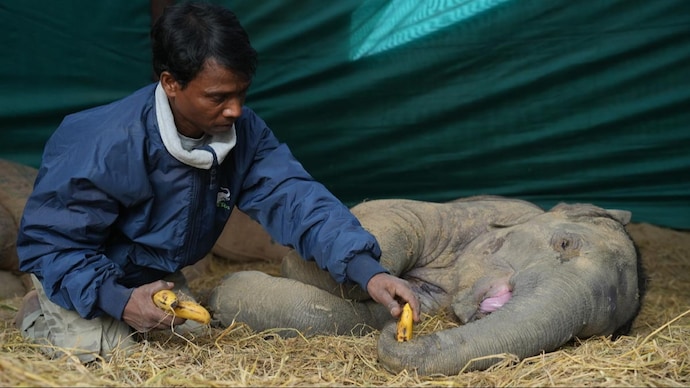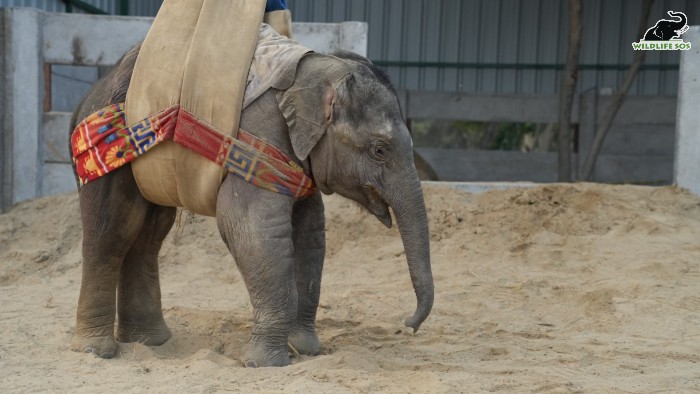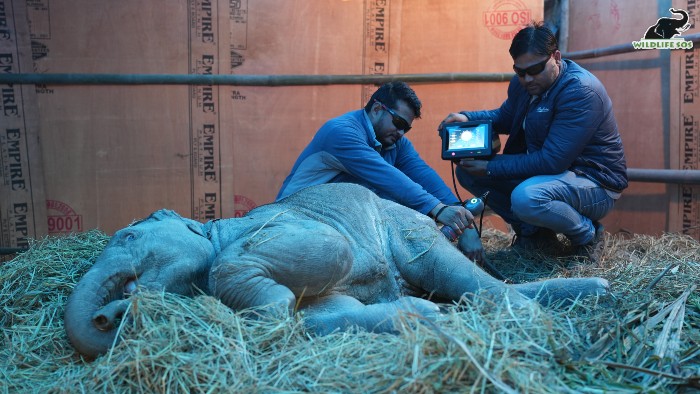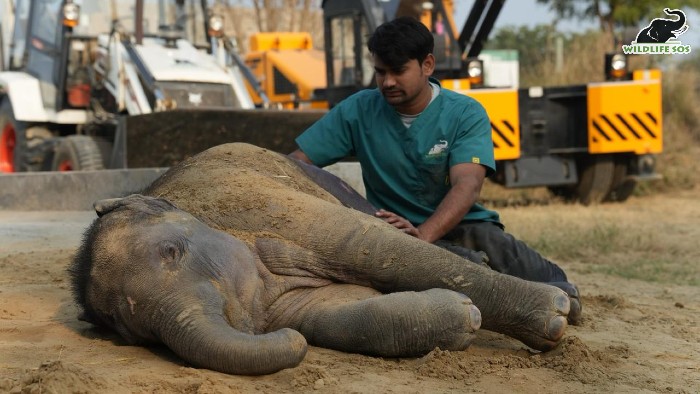The orphaned baby elephant from Jim Corbett Park, struck by a train and fighting to survive, has caused a sensation on social media. What does his fate mean for others of his species?

(Photos: Wildlife SOS)
They say elephants never forget. Does that mean that the nine-month-old elephant calf from Jim Corbett National Park, currently struggling to walk again, will always remember the sight of a train that recently claimed the life of her mother? In the first week of February, a collision with a train in an elephant corridor in the park left the animal orphaned and stranded in a low-height field with multiple injuries.
The elephant calf, now named Bani, had been immobile before being rescued by the Uttarakhand Forest Department and the NGO Wildlife SOS, and transported to the Wildlife SOS Elephant Hospital in Mathura. She arrived with infected open wounds and a stiff left hip joint, exacerbated by lack of movement.
Though stable, continuously lying on her side is taxing on Bani’s heart, lungs, and circulation, and doing so for extended periods poses a risk to her life. “Our veterinarians are brainstorming ways to provide her some comfort despite the abrasive wounds,” says Geeta Seshamani, co-founder of Wildlife SOS. “Only once the wounds heal can we proceed with her treatment in the hydrotherapy pool and then using a support harness. The team is also using soft pads to provide relief from painful wounds between her legs.”

On social media, many have been sharing videos of the baby elephant suckling from a five-liter milk bottle and reaching for bananas, apparently her favorite snack. In a touching gesture of trust, she extends her trunk towards the caregivers. “We are providing baby Bani with a carefully calibrated diet of hydration fluids, succulent green fodder, and bananas every day. In a day, she is given up to three dozen bananas in addition to several liters of milk mixed with soft dalia added as concentrate. Food additives and medications are added to Bani’s diet to balance it. She is showing signs of improvement but the road to recovery is long and requires patience,” reports Dr. D. Ilayaraja, Deputy Director of the Veterinary Division at Wildlife SOS.
Bani is also undergoing laser therapy for joint pain and Transcutaneous Electrical Nerve Stimulation (TENS) therapy for nerves. The team has been cautious in adjusting the frequency and timing of therapy sessions. Bani’s daily routine consists of laser therapy in the morning, followed by comforting oil massages. Every subtle movement she makes is under vigilant observation. On February 13th, the baby elephant managed to stand up for four minutes with the help of a soft harness.

Ironically, the official mascot of Indian Railways is an elephant named Bholu. However, train accidents involving these majestic animals are the second highest cause of non-natural elephant deaths in India, after electrocution.
India hosts the largest population of Asian elephants, around 60 percent of the total population. Official records suggest that nearly 200 elephants died in train collisions between 2010 and 2020, averaging 20 per year.
But there is hope. In 2022, the Tamil Nadu Forest Department became the first to explore the use of artificial intelligence (AI) to prevent train accidents with elephants. And last year, Indian Railways unveiled plans to introduce the ‘Gajraj’ AI-based system to prevent elephant deaths on 700 km of tracks in forested areas.

According to the railways, the system will detect the presence of elephants with 99.5 percent accuracy. The device captures vibration when an elephant approaches the tracks and sends a real-time alert to the control room of the division and a mobile application. The system is capable of detecting and locating moving elephants up to five meters from the fiber optic cable laid beneath the tracks.
Whenever an elephant approaches the tracks, the system generates an alert to the train controller, station master, and train drivers, who can slow down or stop the train. The hope is that this technology will be implemented as soon as possible in states with high elephant populations, and railway staff will be trained in its use to prevent avoidable deaths and trauma to elephants.
“Your voice has power. We are gaining support through an online petition. With 30,000 signatures, we can urge the railways to take action, implementing crucial measures such as reducing speed in elephant corridors and deploying the latest technology [to prevent accidents],” says Seshamani.

Interestingly, in the upcoming Chittagong-Cox’s Bazar railway project in Bangladesh, technology is not the only thing being deployed to keep elephants safe, as the train route will pass through a heavily trafficked elephant corridor in both Bangladesh and Myanmar. There will be underpasses, guide fences, and perhaps the world’s first elephant overpass. There are also plans to improve the quality of forests in protected areas to discourage elephants from venturing outside.
Back in India, while technology and science can help prevent accidental elephant deaths, their success ultimately depends on human willingness to take heed of warnings and remember the importance of these gentle giants.